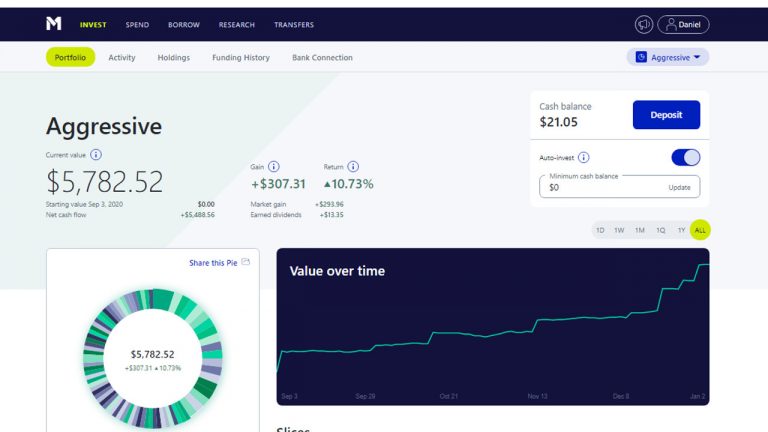Dividend stock investing is an easy way to build a passive income stream that can pay out monthly. Unlike traditional growth stocks, you will get a paycheck at regular intervals from dividend stocks.
When I first started learning how to invest in stocks, I heard a lot about companies like Amazon (AMZN) and Tesla (TSLA). These types of growth stocks are good for generating large positive returns when they are sold.
However, dividend stocks not only increase in value but will pay out part of the company profits to its shareholders periodically. For this reason, I personally love investing in dividend stocks as a way to create income.
- What is the Difference Between Growth and Dividend Stocks?
- What are Dividend Stocks?
- How Much Can I Earn with Dividends?
- Living Off Dividend Stocks
- Create an Easy Passive Income Source
- Dividend Reinvestment Plan (DRIP)
- Getting Started with Dividend Investing
- What are Dividend Aristocrats?
- Top 3 Dividend Stock Picks
- Diversify Your Dividend Portfolio
- When to Buy Dividend Stocks
What is the Difference Between Growth and Dividend Stocks?
Growth stocks are companies that allow you to purchase shares and become a part owner in the company. As a shareholder, you can benefit from an increase in the companies value by selling your shares for more than you bought them for.
Growth stocks are a subset of of traditional stocks that are expected to perform better than others. They tend to be more volatile than others but can offer higher returns.
Of course, stocks can also lose value and there is no guarantee that you’ll make money. I’ll take this time to mention that I am not a financial advisor and that this should not be construed as financial advice. Do your own research and make your own conclusions on how to invest.
With both traditional and growth stocks, there is really only one way to make money with them. Buy shares of the stock at one price and then sell them at a higher price.
Dividend stocks, however, offer a second form of income. Not only can they appreciate in value to be sold at a higher price, but they pay out dividends. This means you earn money while you hold onto your shares without having to sell them.
What are Dividend Stocks?
Dividend stocks are companies that pay out regular dividends to shareholders. Dividends are payments that are made as distributions of the company profits.
In order to be able to do this, dividend companies are usually well-established and have a history of being profitable. To reward their shareholders, they share their profits in the form of a dividend.
Dividends are paid on a set schedule, usually monthly or quarterly. Over the course of a year, dividend stocks may pay out 2% to 3% of their stock price.
When you buy dividend stocks through a brokerage account, you’ll also get them paid out to you that same way. Those dividends can then be transferred out of your account as cash or reinvested to grow your holdings.
How Much Can I Earn with Dividends?
Dividend yield is a measure of how much a stock will pay out in dividends. It is calculated as the annual dividends per share divided by the price per share.
For example, AT&T (T) currently pays out $0.52 per share on a quarterly basis. That means it pays out $2.08 per share on an annual basis. At the current share price of $29.29, the dividend yield is 7.10%.
AT&T has a very strong dividend yield at around 7% while still having relatively low risk as a consistent performer. The majority of stable dividend stocks have returns around the 2% to 3% mark.
There are a few dividend stocks that have dividend yields over 10% but make sure you understand those companies. They may pay out higher dividends to attract investors, but they may not be the best long-term picks.
Investing $1,000 into a dividend stock that has a yield of 3%, you would earn $30 per year. This is in addition to any gain you may earn by having the share price go up.
Living Off Dividend Stocks
Once people realize that they can get paid by owning dividend stocks, they often ask if they can live off dividends. The answer is YES, you can!
With enough invested, you can create a cash income stream without touching your base amount invested. The benefit of this is that, once you invest a certain amount, you can create unlimited passive income.
Let’s say you need $40,000 per year to cover your living expenses. If you invest in dividend stocks that have an average yield of 3%, you would need $1,333,333 in your investment account.
If you are able to increase your dividend yield to 7%, you would only need $572,000 to make $40,000 per year. This is extremely powerful in being able to create income from your investments.
The other benefit of living off your dividends is that the $40,000 you pull out each year will not touch the principal amount you have invested. You will continue to keep your $1.3M in your stocks and not have to sell them.
Create an Easy Passive Income Source
Dividend payments are the ultimate source of passive income. Other than picking the right stocks and investing money into them, there is nothing else that you need to do.
All you have to do is sit back and watch your money earn money. Every couple of months, you’ll get another dividend payment that you can actually use for however you want.
There are not too many other ways to create truly passive income that doesn’t take time and effort to start up. Owning physical real estate requires managing tenants and home repairs. Books, courses, and websites all take a lot of effort to create.
However, dividend stocks can be purchased in minutes with an appropriate amount of research. Other than watching to make sure there isn’t an opportunity to buy or sell your stocks, dividend income is very passive.
Dividend Reinvestment Plan (DRIP)
For those of us that are still building a portfolio and don’t need to cash out the dividends, we can reinvest them. Many brokerage accounts will let you enroll in a dividend reinvestment plan, or DRIP, to grow your portfolio.
DRIP works to buy more shares of your stocks by reinvesting your dividends. Let’s say you earn $60 in dividends that are paid out to your account. Instead of transferring it to your bank account, DRIP lets you buy more two more shares of AT&T, or whatever other stocks you want.
This is an effective strategy to add value to your portfolio and increase the number of shares you own. As those shares increase in value, you will earn more if you sell later on. Owning more shares also increases your dividend payouts.
It is usually a good idea to reinvest your dividends for as long as you don’t urgently need the money. Your portfolio will grow faster and set you up to have a larger passive income stream later.
Once you are ready to retire, you can then turn off your DRIP and take your cash dividend payments to support your lifestyle.
Getting Started with Dividend Investing
Before you jump into dividend investing, make sure you have a strategy and understand the risks. I highly discourage making stock picks solely by going by the highest dividend yields.
When you are first starting out, look for companies that have a history of growth, profits, and increasing dividends. I prefer companies that have been around for a while and I understand their business model. Look for signs that they will continue to evolve and adapt with the times to stay relevant.
There are plenty of ways to research stocks but I like to use the research feature built into my M1 Finance account. It lets me look up any trade symbol and see the historical performance for up the past 5 years. It also provides information on dividend yield, share price, and price/earnings ratio.
Another free tool for researching stocks is Nasdaq.com. Here is a good example of the basic stock information for AT&T (T), along with the dividend information.
As you are starting out with dividend investing, a good place to start with with dividend aristocrats.
What are Dividend Aristocrats?
Dividend aristocrats are blue chip stocks that have a proven history of paying dividends and performing well. They have to be in the S&P 500 and have a history of both paying and increasing dividends for at least the past 25 years.
Dividend aristocrats are essentially the safest, most trusted companies that pay out dividends.
Some of them pay out lower yields of less than 1%, but others can range up to 9%. ExxonMobile (XOM) currently tops the list with a dividend yield of 9.44%, followed by AT&T (T) at 7.27% and Peoples United Financial (PBCT) at 6.75%.
Buyupside has a full list of the dividend aristocrats sorted by their dividend yield as a starting point.
If you are a new investor, it is a good idea to focus on the dividend aristocrats first. As you get more comfortable with investing, you can branch out to other companies that may have higher yields.
Top 3 Dividend Stock Picks
When you are first starting out with your first $1,000 to invest, I usually recommend diversifying with the Vanguard S&P 500 index fund. Besides diversifying your portfolio, it also has a dividend yield of 1.53%. This helps to generate extra income while benefiting from capital appreciation over time.
If you are ready to start branching out into specific dividend stocks, here are three ideas of where to start. I personally hold stock in all of these and believe that they are solid picks.
1. AT&T (T)
As you probably already guessed, AT&T is at the top of my favorite dividend stock list. It has a low P/E ratio of 18.9 and a dividend yield of around 7%. Being one of the largest tech companies, it is continuing to see profits and develop new technology. On top of that, it is a dividend aristocrat with a proven track record of increasing dividend payouts for several decades.
2. Realty Income Corp (O)
Realty Income Corp is a real estate management company that currently has a dividend yield of 4.68%. They have consistently shown historical growth with a large portfolio of commercial real estate tenants. Their list of tenants include Walgreens, 7-Eleven, Dollar General, and FedEx, which means they probably won’t be going anywhere soon.
3. Starwood Property Trust (STWD)
Starwood Property Trust is another real estate trust that pays out a very healthy dividend yield of 9.83%. They have a low 13.6 P/E ratio and consistent growth over the past few years. They provide a combination of commercial lending and property investing that bounced back quickly after COVID-19.
If you invested in the three of these stocks equally, you would make an average of 7.2% in dividends each year, on top of any capital gains.
Diversify Your Dividend Portfolio
Once you start to build your dividend stock portfolio, I would recommend diversifying across multiple companies. Owning too much of one company increases your risk of unexpected issues that could cause you to lose money.
Set a goal of investing in at least 10 to 20 different companies that have solid dividends and that you believe in. I like to hold a mix of less-risky dividend aristocrats and higher-risk stocks that have higher dividend yields.
Of course, make sure you are also diversifying your investments across other forms like physical real estate, ETFs, and precious metals.
When to Buy Dividend Stocks
There are a few different dates to take into account when you buy a dividend stock. Your eligibility to receive the dividend will be based on when you hold shares of the stock.
The first date is the Dividend Declaration Date, which is the date that the company announces that it will pay its next dividend.
The Ex-Dividend Date is the date by which you need to own shares of the stock to be eligible for the dividend. You will need to own the stock by the day before the ex-dividend date to earn the dividend, otherwise the seller gets it.
The ex-dividend date is usually one day before the Dividend Record Date. The record date is the official date by which you need to own shares to receive the dividend. The ex-dividend date was added to give enough time for the stock records to be updated appropriately.
The final date to consider is the Dividend Payment Date, which is when you will actually receive payment to your account.
These dates really only affect you if you are buying or selling dividend stocks. Once you hold them for a period of time, you should receive your dividend payments on the set distribution schedule. For most stocks, this is either monthly or quarterly.
Take these dates into account when you are building your portfolio so that you know when you will get paid. Best of luck with building a dividend stock portfolio that will let you live off the dividends!













